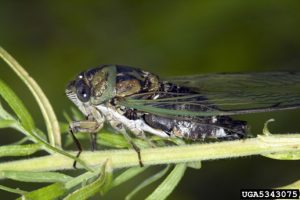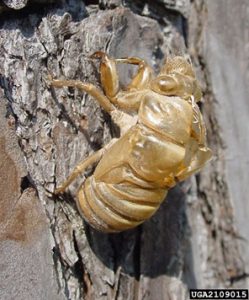Written by Sherie Shaffer, Horticulture Agent, CSU Extension-Pueblo County
Cicadas have been in the news a lot lately, with the emerging of the Brood X group in the Eastern U.S. This big insect news seems to have made people in Colorado interested in learning about cicadas that we have, and we do have them!
What we do not have here in Colorado, are the “periodical cicadas” of the Magicicada species. These cicadas emerge either every 17 years or every 13 years. These are the type that make up Brood X. Basically every year, there are periodical cicadas that emerge in the Eastern U.S. Brood X gets a lot of attention, because it has a wide distribution, and that distribution overlaps with places such as Washington D.C. where they get a lot of media coverage. If you are interested in seeing where periodical cicadas are predicted to emerge each year, check out this link: https://www.cicadamania.com/cicadas/where-will-17-13-year-periodical-cicadas-emerge-next/
So, what about Cicadas we have in Colorado? We do have many, 29 different species to be exact. Cicadas in Colorado can be found every year and are referred to as “annual” cicadas. The term annual is a little misleading, however, because most have a lifecycle that is somewhere between 5-12 years long. They are very large, in my opinion, kind of creepy looking insects. You are more likely to hear them than see them, however. Male cicadas make a variety of distinct sounds to attract females. They don’t typically cause much harm to plants.
The most likely cicada we will hear and sometimes see around Pueblo is the “dog-day cicada” in the genus Megatibicen. They are very large and historically found in Arkansas River Valley. It has extended its range, thanks to plantings made by humans, and now exists all the way up to Ft. Collins. This is the cicada you hear making a loud buzzing sound high up in trees on those “dog days” of summer we so often have.

Figure 1: dog day cicada_David Cappaert, Bugwood.org
Another common species is called Putnam’s cicada Platypedia putnami. This species is out and about right now. It doesn’t make a loud buzzing sound like the dog day cicada, but instead a soft clicking sound that sounds like two coins clicking together.
Cicadas develop underground by sucking fluids from roots. When they emerge from the soil, they will split from their nymphal exoskeleton and fly away, leaving it behind for us to find and wonder, what in the world is that?? Once they emerge from the soil, most cicadas live about 4-6 weeks, most of that time spent mating and for females, laying eggs. Although cicadas live very long for insects (5-12 years around here), most of that time is spent underground.

Figure 2: nymphal skin_Herbert A. ‘Joe’ Pase III, Texas A&M Forest Service, Bugwood.org
So, although we don’t have the large Brood X group of cicadas emerging this summer, there are still many species to look out for every year right here in our back yards.


